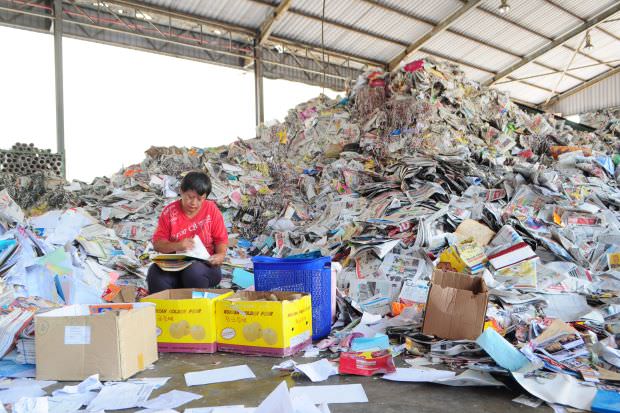Recycling for Earth and cash

THERE IS money to be made in recycling, but most people who do it are not motivated by ringgit and sen.
Singer and actress Sasha Saidin for example declined to accept money from a recycling centre near Pandan Indah for 6kg of used cans, boxes and plastic bottles.
She said it was not about the money.
“It’s about saving the Earth for the future of our children,” said Sasha.
Recycling was ingrained intothe actress and singer by her mother.
“We always used to separate rubbish at home. It has become part of our lifestyle,” said Sasha who recalled that one part of their home was reserved for storing recyclables like plastic bottles, milk boxes, cans and glass.
The recycling habit was reinforced when she spent four years furthering her studies in Britain.
There she discovered there were colour-coded garbage bins indicating where different types of waste should go.
“I won’t throw rubbish away just like that. If I can’t find a proper bin, I’d hold on to it until I get home,” said Sasha, who even takes out staples from paper before putting them aside for recycling.
Beautiful Gate Foundation founder Sia Siew Chin was one of the pioneers in realising there was money to be made out of items considered rubbish.
She realised that volume was the key.
“People throw away things for the most trivial reasons. They say, it’s out of fashion or they want to get rid of something that reminds them of an unhappy event. So, we collect them. Since we started in 1999, our recycling activities have created jobs for disabled members and helped sustain our operations,” said Sia.
She recalled that in one year, their recycling centre located in a house in SS2 Petaling Jaya, reported a gross profit of RM20,000 a month.
Altogether, they have seven branches including Kuala Lumpur, Klang and Malacca.
“Sorting is key in fetching higher prices.
“Book pages have to be torn, their paper separated into coloured and non-coloured. Plastic also has to be sorted. Water bottles should be segregated from detergent containers,” pointed out Sia.
A group of disabled entrepreneurs have set up a spot at the SS2 night market to sell old clothes. They buy the used garments from Sia at a rate of RM1.50 per kg.
The Petaling Jaya centre reports a gross profit of RM2,000 from old clothes alone. A lorry driver who used to work full-time with the foundation gained enough expertise to open his own recycling centre in Perlis.
“He was very good at sourcing for buyers who would give us the best price,” recalled Sia.
Individual recyclers will get better rates if they go direct to recycling centres.
Middlemen like neighbourhood collectors will usually take one look at a heap and offer only a few ringgit for everything.
With main recyclers like one paper packer which handles paper waste for publishers and printing companies in Taman Bukit Maluri Industrial Park, Kuala Lumpur, buying rates start at 20sen per kg.
Black-and-white paper will bring in an extra 10sen. So, a stack of newspapers weighing 46kg will earn the recycler RM13.80.
Many entrepreneurs have jumped on the recycling bandwagon, realising there is good money to be made.
Space, labour and machinery for packing and shredding are three major investments.
“The highest cost is in sorting, as much as 50% to 60%,” said the operator of a paper recycling centre in Taman Bukit Maluri Industrial Park.
Sometimes the paper is wet. As prices go by weight, the recycler ends up buying water instead of paper.
Sorters have also found plastic in between paper stacks.
But impose too many demands and sellers will go elsewhere.
The challenges are not just monetary. Sia had to close her recycling centre when neighbours complained.
They didn’t like the idea of living next to a dumpsite. Without a place to collect and sort the items, income dropped drastically.
“Today, we can make about RM5,000 a month,” reported Sia.
Competition is also keen.
“Many charity organisations are beginning to see potential in rubbish. They are setting up collection bins everywhere,” said Sia.
To gain an edge, one has to be creative like Lee Geok Lan, 63, who turns old clothes into rugs and bags.
Her forte is in cross stitch and she learnt it through the foundation’s programme to help the disabled gain useful skills.
Even some entrepreneurs say it is not about the money.
Steve Wan and Felicia Chew would have led ordinary lives as a web designer and online social marketeer respectively if they had merely popped into a shop to buy each other’s anniversary gift in 2010.
Wan decided to make a badge out of discarded toy parts, old buttons and ribbons. This led the couple to start making costume jewellery and bric-a-brac out of unwanted things.
Their latest collection features bangles and necklaces made out of old magazine pages.
“We do not make much from sales,” said Wan, adding they attach more value to the new friends they have made along the way.
Copper – RM18 per kg
Stainless steel – RM4 per kg
Newspaper – 30sen per kg
Cardboard – 40sen per kg
Mix of plastic items (plastic bottles, containers, pails) – 80sen per kg
Old batteries – 2.50 per kg.
– The Star
Source: https://peraktoday.com.my/2015/12/recycling-for-earth-and-cash/

